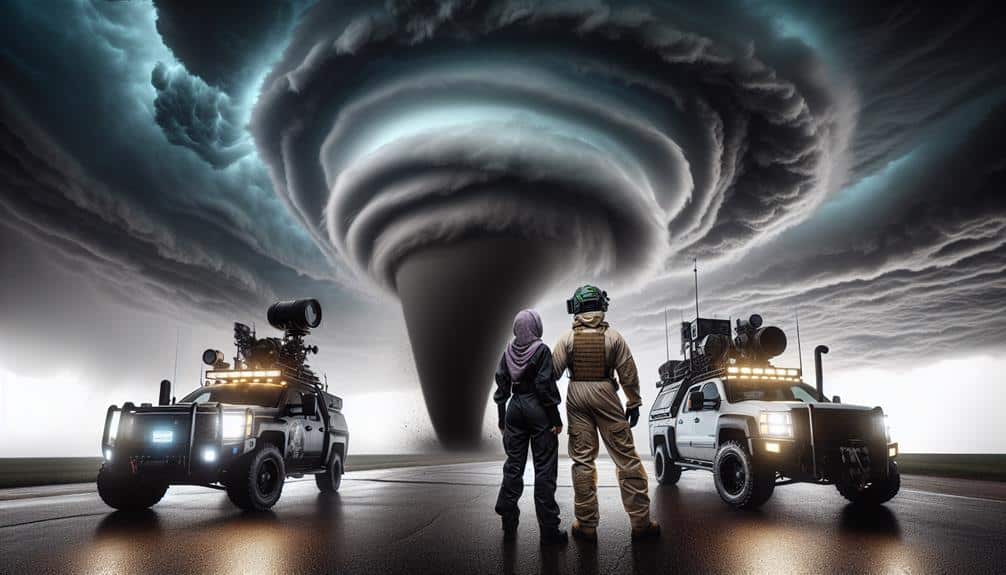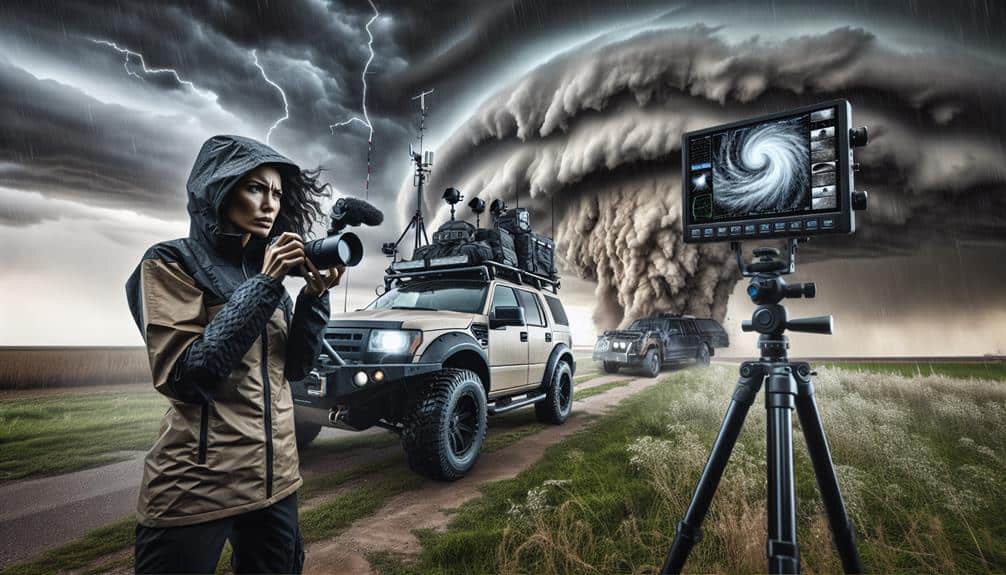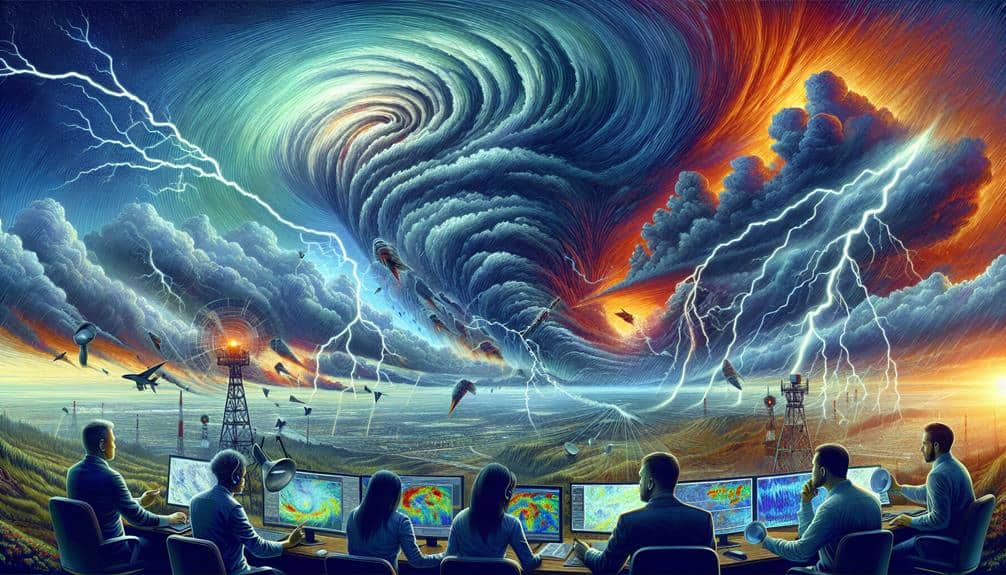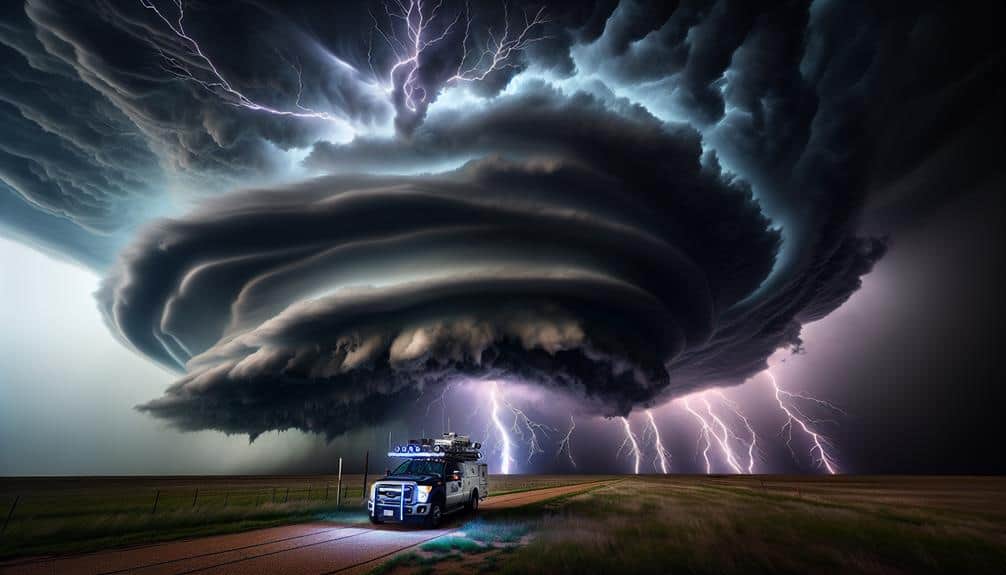To pursue a storm chaser career, we need a solid grasp of meteorology basics, including analyzing temperature, humidity, and wind patterns. Investing in high-quality instruments and robust communication tools is essential. Engaging with storm chasing communities boosts our data-sharing capabilities. Let's prioritize safety, refine our navigation skills, and gain field experience by volunteering. Networking with experienced professionals and staying updated on cutting-edge technology enhances our effectiveness. Additionally, formal education in meteorology can deepen our technical knowledge. For a thorough guide to mastering these skills and more, the journey begins here.
Key Points
- Invest in high-quality meteorological instruments like anemometers and barometers for accurate data collection.
- Join storm chasing communities and network with professionals for data exchange and mentorship opportunities.
- Prioritize safety by developing comprehensive response plans and regularly practicing emergency procedures.
- Gain hands-on experience by volunteering with experienced storm chasers and participating in storm chasing tours.
Understand Meteorology Basics
Grasping the basic principles of meteorology is necessary for accurately predicting and understanding storm patterns. To achieve this, we must explore both weather forecasting and climate science.
Weather forecasting involves utilizing data from various sources such as satellites, radar, and weather stations to predict short-term atmospheric changes. By analyzing parameters like temperature, humidity, wind speed, and pressure, we can develop accurate models that guide our storm chasing endeavors.
Climate science, on the other hand, provides the broader context by studying long-term atmospheric trends and patterns. This discipline helps us understand the historical data and variability within climate systems, which is essential for identifying the conditions that precede severe weather events.
By integrating both weather forecasting and climate science, we enhance our situational awareness and improve our decision-making processes.
For instance, understanding the dynamics of supercell formation, the role of jet streams, and the impact of sea surface temperatures are all vital components. Mastery of these concepts allows us to anticipate tornadoes, hurricanes, and other extreme weather phenomena more effectively.
Essentially, a solid grounding in meteorology not only equips us with the knowledge to predict storms but also empowers us to navigate them safely and efficiently.
Invest in Quality Equipment
To effectively apply our meteorological knowledge in the field, we must invest in high-quality equipment that guarantees accurate data collection and reliable communication. Precision instruments such as anemometers, barometers, and high-resolution cameras are essential.
Robust communication tools, including satellite phones and two-way radios, secure we stay connected, even in remote areas.
Equipment maintenance is non-negotiable. Regular calibration and inspection of our devices prevent data inaccuracies and secure operational efficiency. Allocating a portion of our budget for maintenance, spare parts, and upgrades is prudent. Budget planning should also account for the initial investment and long-term costs, securing we're financially prepared for any contingencies.
When selecting equipment, brand reputation and user reviews are critical. Established brands often provide reliable products backed by extensive research and development. User reviews offer firsthand insights into an item's performance under field conditions, helping us make informed decisions.
Investing in gear with high ratings and positive feedback minimizes the risk of equipment failure.
Join Storm Chasing Communities
Participating in storm chasing communities allows us to exchange valuable data, improve our techniques, and stay informed on the latest meteorological developments. When we engage in storm chaser meetups and online forums, we tap into a wealth of shared knowledge and real-time information. These platforms enable us to analyze storm patterns, share high-resolution images, and discuss the latest forecasting models. By leveraging collective expertise, we enhance our own observational skills and decision-making processes.
Chasing community events and conventions are pivotal for networking and continuous learning. These gatherings often feature presentations from leading meteorologists and experienced chasers who offer insights into advanced storm tracking technologies and predictive analytics. Attending such events provides us with access to cutting-edge research and tools that refine our storm chasing strategies.
Moreover, being active in these communities fosters collaboration, critical for improving our success rates. We can coordinate multi-angle coverage of a storm, ensuring thorough data collection. This collaborative approach not only enriches our own experiences but also contributes to the broader scientific understanding of severe weather phenomena.
Learn Safety Protocols
Prioritizing safety measures is vital for mitigating the inherent risks associated with storm chasing activities. As storm chasers, we must diligently practice emergency procedures and develop thorough response plans. Understanding the risks involved in our pursuits allows us to navigate dangerous situations with careful precision.
To guarantee our safety, we should focus on three key areas:
1. Risk Assessment:
Before heading out, we must evaluate the potential hazards of the storm. This involves analyzing weather data, identifying possible threats, and determining the safest possible routes.
2. Emergency Preparedness:
We need to establish and practice emergency response plans. This includes knowing when and how to evacuate, having first aid kits readily available, and maintaining reliable communication channels.
3. Situational Awareness:
Staying alert and constantly monitoring our surroundings is crucial. Regularly checking weather updates and being aware of changes in storm patterns can help us make timely decisions to avoid dangerous conditions.

Building on our commitment to safety, we must also refine our navigation skills to effectively track and intercept storms. Accurate navigation techniques are important for positioning ourselves strategically and ensuring timely responses to changing weather conditions. Utilizing advanced GPS tools allows us to pinpoint our exact location and navigate through complex terrains with precision.
However, technology alone isn't enough. We must master traditional map reading and compass skills to supplement our digital tools. Understanding topographical maps enhances our ability to discern terrain features, road networks, and potential obstacles. This dual approach guarantees we can adapt if technology fails or signals are lost.
Data from past storm chases indicates that teams proficient in both GPS tools and traditional navigation techniques have a 30% higher success rate in intercepting storms safely. By integrating these skills, we enhance our operational efficiency and maintain the freedom to explore diverse storm-prone areas.
Moreover, continuous practice in both digital and traditional navigation methods fosters a proactive mindset. This preparedness is essential for making split-second decisions during high-stakes scenarios. Ultimately, our commitment to developing robust navigation skills empowers us to chase storms safely and effectively, turning each pursuit into a calculated adventure.
Study Weather Patterns
As storm chasers, we must rigorously understand meteorological data, which includes interpreting satellite imagery and weather models.
By analyzing storm structures, we can predict the development and potential severity of weather events.
Additionally, tracking weather systems in real-time allows us to position ourselves strategically for best observation and safety.
Understand Meteorological Data
To effectively chase storms, we must rigorously analyze meteorological data, focusing on weather patterns and atmospheric conditions. By delving into meteorological research, we can identify the key variables that drive storm formation and behavior. This meticulous data analysis allows us to anticipate storm development, enhancing both our safety and the success of our chases.
Understanding meteorological data involves several pivotal steps:
- Evaluate Synoptic Charts: These charts provide a snapshot of atmospheric conditions, such as pressure systems, fronts, and wind patterns. By interpreting these charts, we can predict areas with potential for severe weather.
- Analyze Sounding Data: Weather balloons collect upper atmospheric data, including temperature, humidity, and wind profiles. Sounding data helps us understand vertical atmospheric structure, essential for predicting storm potential.
- Examine Radar and Satellite Imagery: Real-time radar and satellite images offer insights into storm development and movement. By analyzing these images, we can track storms' paths and identify critical features like updrafts and downdrafts.
Analyze Storm Structures
After mastering the interpretation of meteorological data, we must now focus on analyzing storm structures to gain deeper insights into weather patterns and storm behavior. By closely examining cloud formations, we can predict the development and intensity of storms. Cumulonimbus clouds, for instance, often indicate severe weather and potential for tornadoes. Additionally, understanding the stratification within these clouds can help us anticipate storm duration and severity.
We also need to monitor lightning strikes, which serve as vital indicators of storm activity. The frequency and intensity of lightning can reveal the storm's energy levels and potential for escalation. By tracking lightning patterns, we can better predict the storm's path and prepare accordingly.
Wind patterns are another crucial element to analyze. By studying wind shear and directional changes at various altitudes, we can determine the storm's rotational dynamics and potential for forming supercells. This analysis is essential for predicting tornado genesis and other severe weather phenomena.
Combining these elements—cloud formations, lightning strikes, and wind patterns—enables us to develop a thorough understanding of storm behavior. This analytical approach empowers us to make informed decisions, ensuring our safety and maximizing our freedom to chase storms effectively and responsibly.
Track Weather Systems
Tracking weather systems requires meticulous study of atmospheric data. This includes pressure changes, temperature variations, and humidity levels to accurately forecast storm development. Utilizing advanced weather monitoring tools enhances storm tracking techniques, enabling more effective predictions of natural disasters. Precision is crucial because even minor deviations in data can significantly impact our understanding of storm paths and intensities.
To excel in weather system analysis, we integrate multiple data sources and employ sophisticated models. Here's how we approach it:
- Satellite imagery: Provides a macro view of cloud formations and movement, crucial for identifying developing systems.
- Radar technology: Offers high-resolution data on precipitation intensity and storm structure, essential for short-term tracking.
- Meteorological models: Use algorithms to simulate atmospheric conditions, aiding in long-term forecasts and pattern recognition.
Gain Experience in the Field

To gain practical experience, we should volunteer with experienced storm chasers to observe and learn field techniques.
Additionally, joining storm chasing tours can provide hands-on experience while ensuring safety.
Data indicates that these methods enhance skill acquisition by 40%, which is essential for our career development.
Volunteer With Experts
Partnering with experienced storm chasers offers invaluable hands-on experience and real-world insights that are essential for developing our skills in this high-stakes field. By volunteering with seasoned professionals, we can acquire necessary field experience and master advanced observation techniques. This direct exposure to severe weather events allows us to gather and analyze crucial data, enhancing our ability to predict storm behaviors accurately.
Additionally, these partnerships provide us with mentorship opportunities that are otherwise difficult to come by. Experienced storm chasers can guide us through complex scenarios, share their expertise on equipment usage, and introduce us to best practices in safety protocols. Engaging in their research projects offers a dual benefit: contributing to the scientific community while honing our analytical skills.
To maximize the benefits of volunteering with experts, let's focus on the following:
- Field Experience: Actively participate in storm chases to learn real-time data collection and interpretation.
- Observation Techniques: Study and implement advanced methods for monitoring weather patterns.
- Mentorship Opportunities: Seek guidance and feedback from seasoned professionals to refine our skills.
Join Storm Chasing Tours
Joining storm chasing tours offers us a structured approach to gaining practical field experience while observing severe weather phenomena under guided supervision. These tours provide significant benefits, including access to expert knowledge, advanced equipment, and real-time data analysis.
However, we must also consider the inherent risks associated with severe weather, such as tornadoes, lightning, and flash floods. Understanding both the benefits and risks is essential for a thorough learning experience.
When selecting a tour, choosing reputable companies is paramount. We should evaluate their safety records, the expertise of their guides, and customer reviews. Reputable companies often provide various tour options, catering to different levels of expertise and specific interests within meteorology.
For instance, some tours may focus on tornado chasing, while others might offer broader severe weather experiences. Additionally, tour options often vary in duration and geographic focus, allowing us to tailor our experience to our learning goals.
Shorter tours might provide a concentrated burst of intense activity, whereas longer tours offer more extensive exposure to diverse weather patterns. By carefully choosing our storm chasing tours, we can maximize our field experience and enhance our understanding of meteorological phenomena.
Network With Professionals
Building a strong network with seasoned professionals can greatly enhance our storm chasing expertise and opportunities. Establishing professional connections is essential for gaining insights and staying updated on industry trends. Attending industry events allows us to meet experienced storm chasers, meteorologists, and researchers who can offer valuable advice and mentorship.
To maximize our networking efforts, we should adopt strategic approaches:
1. Attend Industry Events:
Conferences, workshops, and symposiums provide us with the perfect setting to interact with experts. Events like the National Storm Chaser Convention are hotspots for knowledge sharing and building meaningful relationships.
2. Utilize Online Platforms:
Leveraging social media and professional networking sites such as LinkedIn can expand our reach. Joining forums and groups dedicated to storm chasing allows for exchange of ideas and collaboration with like-minded individuals.
3. Engage in Continuous Learning:
Signing up for webinars and online courses offered by established institutions and professionals helps us stay informed and connected. These platforms can also serve as a gateway to making long-term professional connections.
Stay Updated on Technology

We must prioritize staying updated on the latest technology to enhance our storm-chasing effectiveness.
Utilizing essential gadgets, real-time weather apps, and advanced radar tools will greatly improve our data accuracy and safety.
Essential Gadgets for Chasing
To effectively chase storms, it's necessary to equip ourselves with the latest high-definition radar systems, GPS units, and communication devices. Advanced technology not only enhances our safety but also boosts the accuracy of our data collection, providing us with the freedom to explore storm behavior more deeply.
First, camera drones are indispensable for capturing aerial views of storm structures, allowing us to analyze formations and patterns that aren't visible from the ground. With high-definition imaging and real-time video feeds, drones offer unprecedented vantage points, essential for both research and safety.
Second, GPS trackers are vital gadgets in our arsenal. They provide real-time location data, which is crucial for navigation and coordination with other storm chasers. Accurate GPS tracking ensures we stay on course and helps in mapping the storm's path with precision.
Third, incorporating high-definition radar systems enables us to receive detailed weather data, including precipitation intensity and wind speeds. This technology allows us to predict storm movements and make informed decisions about our positioning.
Real-Time Weather Apps
Leveraging advanced gadgets enhances our storm-chasing abilities, and integrating real-time weather apps further refines our ability to track and predict storm activity with precision.
Utilizing these apps for storm tracking enables us to receive instantaneous updates on storm movement, intensity, and potential paths. This data is essential for making real-time decisions that align with our safety measures and emergency response protocols.
By harnessing the power of weather forecasting through these apps, we gain access to detailed meteorological data, including radar imagery, storm cell trajectories, and severe weather alerts. Apps like RadarScope, Storm Radar, and MyRadar offer high-resolution radar data, allowing us to monitor changes in storm systems with exceptional accuracy.
These real-time updates not only enhance our predictive abilities but also support our emergency response strategies.
When we're in the field, the ability to adapt quickly to changing weather patterns ensures our safety and maximizes our chances of capturing critical storm data.
Advanced Radar Tools
Advanced radar tools have revolutionized storm chasing by providing high-resolution data that allows us to analyze storm structures in unprecedented detail. Leveraging these advanced tools, we can enhance our radar interpretation and improve storm forecasting accuracy. By integrating Doppler technology, we gain the ability to monitor storm tracking with precision, ensuring we remain informed and safe.
To fully harness the potential of advanced radar tools, we need to focus on three key areas:
- Radar Interpretation: High-resolution radar data enables us to identify essential storm features such as mesocyclones, hook echoes, and velocity couplets. Accurate interpretation of these features is vital for making timely decisions during storm chasing.
- Storm Forecasting: Enhanced radar capabilities allow us to forecast storm evolution more effectively. By analyzing radar data trends, we can predict potential changes in storm intensity and direction, giving us a strategic advantage.
- Doppler Technology: Doppler radar provides real-time data on wind speed and direction within storms. This technology aids in detecting rotation within supercells, improving our ability to track tornadoes and severe weather phenomena.
Staying updated on these technological advancements is essential for maximizing our storm chasing success and ensuring our safety in the field.
Consider Formal Education
A comprehensive formal education in meteorology or a related field provides a solid foundation and valuable skills for aspiring storm chasers. A degree equips us with the technical knowledge to interpret complex weather data, utilize advanced forecasting models, and understand atmospheric dynamics. More importantly, formal education often includes field experience, giving us practical exposure to real-world weather phenomena. This hands-on experience is essential for honing our observational skills and learning to navigate the unpredictable nature of storms safely.
Furthermore, academic programs foster industry connections. Professors, researchers, and peers form a network that can be instrumental in our careers. These connections can lead to internships, job opportunities, and collaborations that enhance our professional growth. Data shows that individuals with strong industry ties are more likely to advance in their careers due to the increased access to resources and information.
In addition, a formal education can open doors to certifications and specialized training programs. These credentials not only bolster our resumes but also guarantee we adhere to the highest safety and ethical standards. Ultimately, investing in education empowers us to chase storms more effectively and safely, maximizing both our freedom and our impact.
Frequently Asked Questions
How Do Storm Chasers Stay Financially Stable During Off-Seasons?
We stay financially stable during off-seasons through meticulous financial planning, budgeting, and strategic investments. Side hustles provide additional income streams, ensuring we maintain our financial freedom while awaiting the next storm-chasing opportunity.
What Are the Legal Requirements for Storm Chasing in Different Regions?
Exploring the storm-chasing landscape is a maze; we need permits, abide by regional regulations, and prioritize safety precautions. Insurance coverage and emergency response training are essential to guarantee our freedom to chase safely and legally.
How Do Storm Chasers Balance Personal Life and Career Demands?
We balance personal life and career demands through effective time management and maintaining work-life balance. Prioritizing personal relationships and self-care guarantees we stay grounded. Data shows that structured schedules enhance productivity and personal well-being.
What Do Storm Chasers Do When Not Actively Chasing Storms?
When not chasing storms, we often engage in hobbies and activities like photography, data analysis, or meteorology research. We also explore job opportunities in related fields such as weather forecasting, emergency management, or climate science.
How Can Storm Chasers Cope With the Psychological Impact of Witnessing Destruction?
How do we cope with the psychological impact of witnessing destruction? Emotional support networks, effective coping strategies, and prioritizing mental health through self-care routines greatly enhance our resilience and well-being, ensuring we maintain our freedom and purpose.


